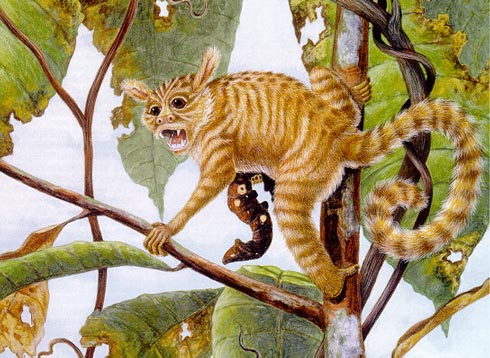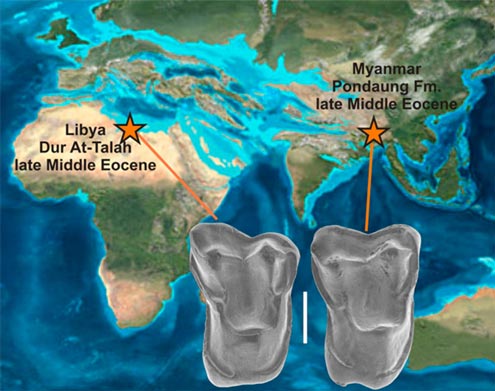Are we all Asian Migrants?
For many years, one specialist branch of the science of palaeontology, those scientists who have been studying the origin of apes and the evolution of the primates (palaeoprimatologists), have puzzled over the exact origins of these creatures, a branch of which gave rise to the hominins and ultimately our own species H. sapiens.
The Origin of Apes
Although the fossil record of Early Cenozoic (Palaeogene) primates is exceptionally poor, a number of hypotheses had been put forward that supported an African origin for what is termed the anthropoids (monkeys, apes and ultimately hominins). However, recent fossil finds, most notably in China had began to challenge these theories. The discovery of four very primitive teeth in Myanmar (Burma), lends support to the notion that the anthropoids originated in the Far East and not from Africa as previously thought. A paper has been published in the scientific journal (the Proceedings of the National Academy of Sciences), that suggests that this group of mammals originated in Asia and migrated westwards into Africa.
The anthropoids were almost all entirely arboreal (tree dwelling). During the Palaeogene, the geological period that immediately followed the demise of the Dinosauria (Cretaceous), average annual temperatures seem to have been relatively stable, with the world being approximately six degrees warmer than today. High humidity and rainfall led to extensive forestation. Global temperatures began to rise and by around fifty million years ago the average, annual global temperature was somewhere in the region of twenty-eight degrees Celsius. Earth became a lush, tropical paradise with rainforests extending from Canada down to the tip of Chile in the western hemisphere and from the southern tip of Norway to the south of Australia in the eastern hemisphere. Even the British Isles, those bits that were above sea level; was a tropical paradise, with crocodiles basking on the banks of a river system that resembled the Congo river seen in western Africa today.
Eosimias centennicus
Expeditions jointly organised by the Carnegie Museum of Natural History (Pittsburgh) and the Institute of Vertebrate Palaeontology and Palaeoanthropology (Beijing) to the Shanxi Province of China in the mid 1990s uncovered evidence of some of the earliest anthropoids known. Specimens such as the tarsier-like Eosimias centennicus, fossils of which were found in sediments along the Yellow River show that primitive anthropoids inhabited eastern Asia millions of years before they are represented by such nearly complete fossils in the African fossil record. Because the nearest living relative of anthropoid primates occurs only in southeast Asia and because some of the earliest and most primitive fossil Anthropoids are known from Asia, it seems likely that the anthropoid clade actually originated on the Asian landmass. Now new fossils from Burma add weight to this hypothesis and provide a timeline for the Anthropoids migration out of Asia and into Africa.
An Artist’s Impression of a Primitive Anthropoid (E. centennicus)
Picture credit: Nancy Perkins.
Prosimians, including our early ancestors thrived and rapidly diversified. However, animals living in forests have a poor potential for fossilisation. Any remains are usually scavenged or rot away leaving nothing available for any type of fossilisation processes. Occasionally, small fragments of fossil material are found, often individual teeth or part of a jawbone that had been transported by a river system, depositing the bone and enamel material many miles from where the animal may have actually lived.
To read about a recent fossil primate discovery: New Fossil Primate Discovered – Deep in the Heart of Texas.
Building up a more complete picture of the origin and early evolution of the anthropoid apes has occupied a number of academics for many years. Most scientists agree that our hominin branch of the ape family tree, did originate in Africa, but the discovery of just four teeth in Burma, dating from 37 million years ago, suggest that the apes themselves may have evolved in the east before migrating westwards into Africa sometime during the Middle Eocene.
An Ancient Swamp
An international team of scientists, examining the strata laid down in an ancient Eocene swampland that covered what was to become Myanmar (Burma) have found amongst the fossil remains of fish, ancient turtles and primitive hippos four fossilised molars that belong to a new species of small primate. The teeth resemble those of an already described African species, yet they show some more primitive, basal traits. These fossil teeth suggest that the African apes could be descended from an Asian ancestral clade that migrated westwards, skirting around and across the rapidly shrinking Tethys Ocean to Africa.
The first tooth was found in 2005, a further six years of field work only yielded three other teeth, emphasising how rare anthropoid fossils are, but these are enough for the research team to describe and name a new species.
Palaeontologist K. Christopher Beard of the Carnegie Museum of Natural History in Pittsburgh, Pennsylvania (United States) and the research team leader, Jean-Jacques Jaeger of the University of Poitiers, France, in association with colleagues were able to name and describe a new species of anthropoid based on the shape and size of the molars they had found. The new species has been named Afrasia djijidae.
Eocene Teeth from Myanmar (Burma) indicate Asian Origin of Anthropoids
Picture credit: K. Christopher Beard/PNAS.
Primate fossil teeth from fossil beds in Myanmar suggest our deep primate ancestors arose in Asia.
Commenting on the difficulties of finding fossil evidence of early primates, Dr Beard, curator of Vertebrate Paleontology at Carnegie Museum of Natural History, stated:
“It’s a difficult place to work, in six years we found just four teeth.”
The teeth are extremely significant. Scientists had postulated that early anthropoids hailed from Asia, but lacked the fossil evidence to provide an indication of the timing of a migration westwards into Africa. The research work on the fossil beds, part of the Pondaung Formation (Mid-Upper Eocene), near to the village of Nyaungpinle in Myanmar have revealed evidence that 37-38 million years ago there was living in Asia an anthropoid that seems very closely related to, but slightly more primitive than, a genus of fossil African anthropoids.
Finding fossils of early primates is a very rare event, to read about the discovery of a new species of Tarsier from the Miocene of Thailand: The remains of an Eagle’s dinner helps scientists to identify new species of Miocene Tarsier.
These teeth, small though they are, were enough to demonstrate that the Burmese Afrasia djijidae, was closely related to another early, primitive anthropoid that lived roughly around the same time, but whose fossils have been found in North Africa (Libya) – Afrotarsius libycus.
Microscopic analysis of the teeth showed that the teeth from Burma and Libya were extremely similar, such an affinity between Asian and African anthropoid fossils has not been demonstrated before. Subtle differences, such as a tiny bulge at the back of what would have been the last, lower molar in the jaw of the Burmese anthropoid suggest that the Pondaung discoveries represent a more primitive, basal member of the anthropoid clade.
These primitive traits suggest that this group of mammals evolved in Asia and migrated to Africa somewhere between 39-37 million years ago. Writing in the Proceedings of the National Academy of Sciences, the research team postulate that the “Out-of-Asia” migration was most likely not a single event but a complex migration of a number of genera westwards. However, once in Africa, these primitive tarsier-like creatures thrived, perhaps the tropical conditions were ideal for them or perhaps they were fewer predators. This particular group of the primate family tree, underwent rapid evolution and diversification and a number of species have been recorded in the fossil record of Africa just shortly after the proposed “Out-of-Asia” migration event.
Dr Beard described the rapid diversification as a “starburst of evolution.”
Others agree that if both the new species of primates from Myanmar and Libya are indeed early anthropoids, they would greatly strengthen the case for the Asian origins of this type of animal. Vertebrate palaeontologist, Richard Kay of Duke University (North Carolina), stated:
“If proven, the biogeographical significance of these results is profound.”
Ultimately, if the apes evolved in Asia, then our own human origins can be traced back to this part of the world. Human-like creatures (hominins) evolved in Africa but their ancestors may have originated in the East.
Dr Beard added:
“We’ve all heard about Out-of-Africa for human origins. Now we think there was an Out-of-Asia migration into Africa first.”
For replicas and figures of prehistoric mamals and other creatures: Papo Prehistoric Animals (Les Dinosaures).







Leave A Comment